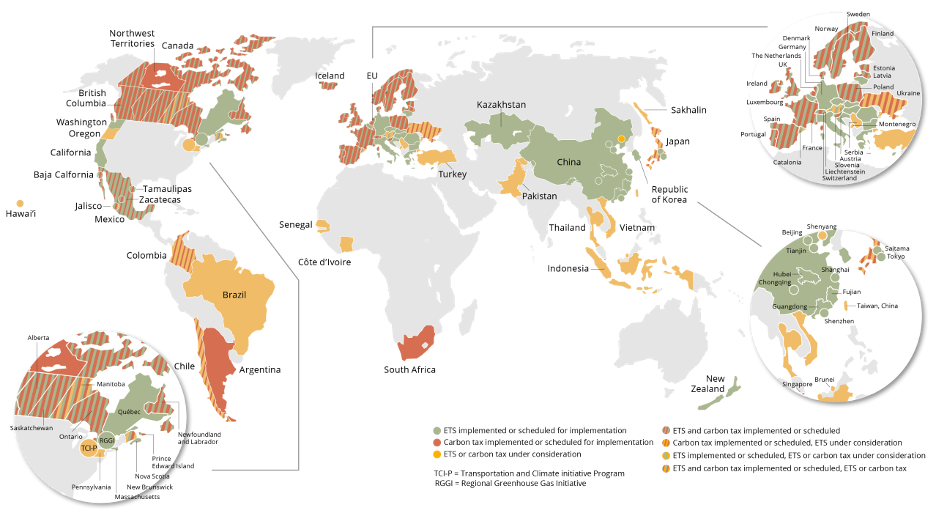Giving Credit Where It Is Due: How Carbon Cap-And-Trade Could Help Georgians
Janisse Ray, in her autobiography “Ecology of a Cracker Childhood,” discusses her childhood growing up in south Georgia, surrounded by the towering longleaf pines of the South. Through stories of her family and of Georgia’s natural history, she describes the significance of the Georgia landscape to her.
Though many of Ray’s cherished longleaf pine forests are today fragmented and threatened, Georgia still has 22 million acres of commercially available, private timberland – more than any other state. And in addition to the many cultural and aesthetic benefits of forests that Ray describes, Georgia forests provide billions of dollars in timber, food, fuel, habitat and ecosystem services every year.[1] Soon, that could be expanded to include one more service: carbon sequestration.
The sequestration of carbon through “carbon sinks” such as forests and the ocean is a crucial step in reducing greenhouse gas emissions and stopping climate change before it is too late. But what if there were an opportunity for Georgia forests to not only provide this valuable service to the planet but also generate economic growth and jobs through it? That is where cap-and-trade programs for carbon, like the Regional Greenhouse Gas Initiative, come in.
Cap-and-trade is a method for reducing emissions of a pollutant to a desired level by requiring that all polluters obtain permits for every unit of pollutant they emit. This could mean purchasing a permit from a central authority, buying permits from other polluters or offsetting carbon via sequestration projects. This would make polluters factor the environmental and social cost of emitting greenhouse gas into their production costs. And according to the basic laws of supply and demand, when the price of something rises, people will demand less of it. So putting a price on carbon decreases the amount of CO2 humans put into the air to the desired level. Along with carbon taxes, cap-and-trade is one of the main policy tools for regulating emissions levels, and various iterations of it have been discussed and supported by economists for years.[2]
It is not just theoretical, though. The World Bank created a map that summarizes all carbon taxes and emission trading systems (ETS) around the world.[3] As of 2020, there were 64 carbon pricing programs around the world, and 3 scheduled for implementation. In the U.S. there is only one interstate greenhouse gas cap-and-trade program currently in force: the Regional Greenhouse Gas Initiative (RGGI).
RGGI is a non-profit comprising 11 states, mostly in the Northeastern U.S.[4] Its goal is to limit emissions from the energy sector, which in Georgia is the source of 71% of its greenhouse gas emissions.[5] The way it works is by setting a regional, enforceable limit (“cap”) on carbon emissions from power plants and selling permits up to this cap via quarterly auctions. Power plants can bid on and purchase these permits, which allow them to emit a defined number of tons of CO2-equivalent. If power plants have more permits than they need, they can sell them to other plants, and vice versa. This allows the polluters who can most efficiently cut down on their pollution to do so. Proceeds from permit auctions are then invested back into communities via weatherization, energy efficiency upgrades and renewable energy infrastructure.[6]
One interesting feature of RGGI is that power plants can meet up to 3.3% of their CO2 obligation via carbon offset projects in other RGGI states. Examples include reforestation, improved forest management or avoided conversion.[7] This may not seem like a lot, but the overall adjusted cap across RGGI states for 2022 is 97,022,454 tons of CO2 – 3.3% of this is over 3.2 million tons of CO2,[8] which Georgia forests alone could offset many times over.[9]
To get an idea of how large of an economic benefit this would bring Georgians, the 3.2 million tons of CO2 that could be offset by Georgia forests is multiplied by $13.50, the clearing price per ton in the latest RGGI auction in March 2022.[10] This means that Georgia could potentially be receiving over $43 million in economic benefits if it were part of RGGI, solely from carbon offset projects. And with the market clearing prices for RGGI auctions steadily rising every year, this number would only grow.
There are of course many other benefits, besides those to the forestry industry, that Georgia could receive should it join the Regional Greenhouse Gas Initiative or enter some other carbon cap-and-trade program: increased investment in renewables, achievable emissions targets more in line with international goals and a recognition of the desperate need for a reduction in the world’s greenhouse gas emissions.
The infrastructure and precedent are there: RGGI already provides detailed information on the procedures for formally joining RGGI;[11] the Georgia Carbon Sequestration Registry already publishes official information on carbon sequestration projects in the state;[12] and North Carolina has made steps to join RGGI, making it the Southernmost state so far to take steps to join the program.[13] And perhaps, by allowing Georgia forestry to take advantage of the economic and environmental benefits cap-and-trade could bring, we could finally give the beloved forests blanketing the Georgia landscape the credit they deserve.
[1] https://gfagrow.org/advocate/numberone/
[2] https://www.brookings.edu/blog/planetpolicy/2014/08/12/pricing-carbon-a-carbon-tax-or-cap-and-trade/
[3] https://openknowledge.worldbank.org/handle/10986/35620
[4] https://www.rggi.org/program-overview-and-design/elements
[5] https://www.climatelinks.org/resources/greenhouse-gas-emissions-factsheet-georgia
[6] https://www.nrdc.org/resources/regional-greenhouse-gas-initiative-model-nation
[7] https://www.rggi.org/program-overview-and-design/design-archive/mou-model-rule
[8] https://www.rggi.org/program-overview-and-design/elements
[9] https://gatrees.org/forest-management-conservation/carbon-sequestration/
[10] https://www.rggi.org/index.php/auctions/auction-results
[11] https://www.rggi.org/program-overview-and-design/new-participation
[12] http://gacarbon.org/GFCCSHome.aspx?AspxAutoDetectCookieSupport=1
[13] https://nclcv.org/cib07192021-rggi/

